

> From: Max Cooper
Some more data from my recent pump/gauge install.
Placing the fuel pressure gauge sender between the stock regulator and a rising-rate regulator will cause it to read zero until you are on boost. Then it will read just the pressure it is adding. So, at 10 psi boost with a 2:1 rate dialed in, it would read 20 psi, where the actual fuel pressure would be 37 psi + 10 psi + 20 psi = 67 psi. Yes, I actually had the sender installed in the wrong place to verify this. ;-)
______________
Date: Tue, 8 Aug 2000
From: "Kevin J Kelleher" (Kevin.J.Kelleher@USA.dupont.com)
The back pressure from the 2nd regulator only works on a very small area of the diaphram, equal to the bore of the 1st regulator's discharge stand pipe. This is why the 2nd regulator does not add a step in pressure to the first. For any series regulator set-up, properly sized for flow, the unit which regulates to a higher pressure will govern, whether front or back unit, and the other regulator goes wide open in a futile effort to reduce line pressure.
The M2 RRFPR's are the basic Bell unit, with no internal spring or adjustable reference pressure. The mechanical rate is about 6:1, and this is reduced as needed with a pressure bleed on the boost signal. It must be used in series with a stock regulator.The regulated pressure for this RR unit is simply the gain times the boost, so you get 60 psi line pressure at 10 lbs, 90 psi at 15 lbs. At 6:1, the boost pressure where the 2nd RR unit takes over is simply found:
37 + P = 6*P, so P = 7.4 psi boost at crossover
It is likely the SR is like this since you read zero psi between the reg's at vacuum conditions.
________________
From Max Cooper
I am not sure I understand what you are saying is different. Please elaborate with an example, including: boost pressure, fuel rail pressure, pressure between stock regulator and regulator.
Here is my understanding of what you are saying, using 10 psi boost pressure. The pressures from the regulators are not strictly additive. Instead, the rail pressure will be 37 + 10 psi from the stock regulator + 1/6 of the pressure between the two regulators, assuming the ratio of the first regulator's discharge pipe area to it's diaphragm area is 1:6 (a total guess). So, if we read 90 psi between the regulators, that would give a rail pressure of 37 + 10 + 90/6 psi = 37 + 10 + 15 psi = 62 psi. Is this what you mean?
I find it troubling that the pressure between the regulators would be so high, and that the pressure in the rail could be anything lower than the pressure in the discharge tube of the first regulator. However, that may be a false intuition problem on my part, I don't really know.
_______________
Date: Tue, 8 Aug 2000 15:10:08 -0400
From: "Kevin J Kelleher" (Kevin.J.Kelleher@USA.dupont.com)
The rise rate of a regulator is based only on the upper dry area, vs the lower wet area (ratio). The point about the small discharge tube in front reg is that it is an insignificant small part of the wet area, and any 'between' pressure force at this small spot is ignored. Your intuition is correct ....pressure between reg's never exceeds line pressure.
For properly sized series reg's, and a given boost, the reg that has the higher 'stand alone' regulated pressure will govern/control at that pressure .... there is no "10 from stock + 1/6x from the second reg" type stuff.
IF the rear RR 'stand alone' controlled pressure is higher at a given boost, the pressure between the reg's is fuel rail pressure, and the front regulator is wide open, same fuel line pressure in and out, since it is trying to reduce line pressure and the 2nd reg won't let it. The rear RR controls line pressure as if the front reg is not there. Fuel rail pressure is then define by Pf = RR * boost
IF the front reg is higher (your set-up at low boost or vac), the pressure between regs will be less than line pressure, and will be just 'Pf' per above eq'n (I was wrong on this in prev msg below, thinking inactive reg is always wide open). For vac in manifold, your type of RR reg will go wide open to the low tank return line pressure both in and out. The fuel supply line pressure will be per the front stock regulator, Pf = 37 + boost
note:
You can add a more elaborate RR reg at the rear, with a fixed or adjustable basic control pressure like the stock reg, ie 2.5 bar or 37 psi. The logic is the same as above, except the equation for the RR reg become Pf = XX + (RR * boost), where XX is the set basic control pressure, like 37 psi. This type of RR would be a good choice for mods with stock ecu, with a lower RR active across most of the operating range, vs just higher boost kick-in like Wael's and yours.
________________
Date: Wed, 13 Sep 2000 15:37:25 -0500
From: "Westbrook, Chuck E." (CWestbrook@tmh.tmc.edu)
Subject: (rx7) [3] FPR Solenoid Operation
The FPR solenoid is connected to the intake manifold near the block and to the FPR. When opened, it allows the FPR to directly respond to vacuum or boost. When starting a hot engine, the ECU will close the solenoid so that the FPR senses 0 vacuum/boost and deliver a higher fuel pressure to insure vapor lock does not occur. Anyway that's what I read. How is vapor lock going to occur with a pusher pump at 34PSI? Must be that Japanese fuel!
So the solenoid is only used for starting purposes where it really isn't needed, (similar to the AST). If it goes bad and causes a decreased pressure to the FPR, then your engine will go lean. That is why some owners bypass the solenoid.
________________
From Spencer Hutchings:
I was having a lean condition reported to me by my Cyberdyne A/F Ratio gauge so on the advise of Eric at XS Engineering I installed an SX Fuel Pressure Regulator in place of the factory unit. Didn't solve the problem, but that is a different story.
Anyway . . .
This modification was a big deal to me since I had to permanently alter my stock secondary fuel rail. It involved removing and tapping the secondary rail for an AN to NPT elbow. I constructed several -6 AN Aeroquip hoses and fabricated a mounting bracket for the SX regulator. A Summit liquid filled 0-60PSI fuel pressure gauge was used on the vacant side of the regulator to set the idle fuel pressure at 45PSI (Stock is 38).
The filter was no big deal. No cutting required. I put a piece of fuel hose where the stock filter used to be and put the new System One filter in the engine compartment. I did have to run a rather long section of hose off one end of the filter to keep it from kinking.
Update 11/98 - Moved the fuel filter closer to the firewall and hid it under the sump. Wrapped with rubber to keep it from getting scratched or from banging around.
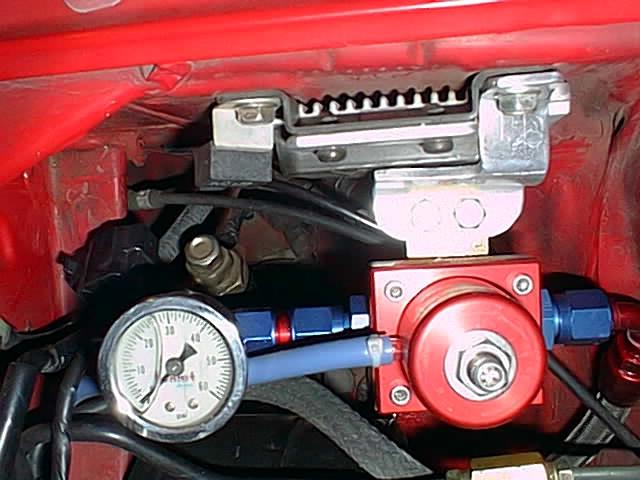
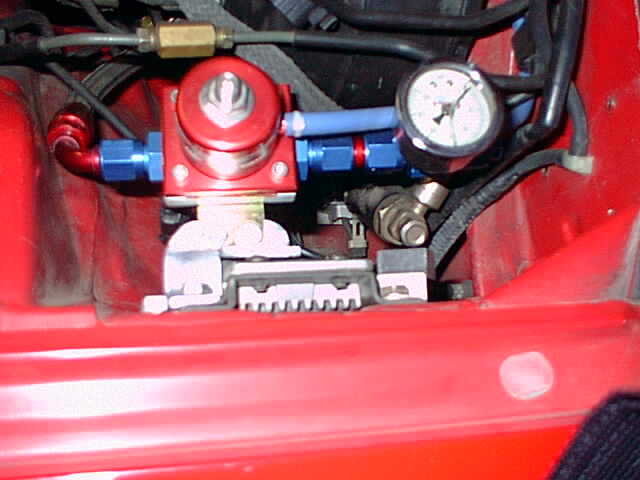
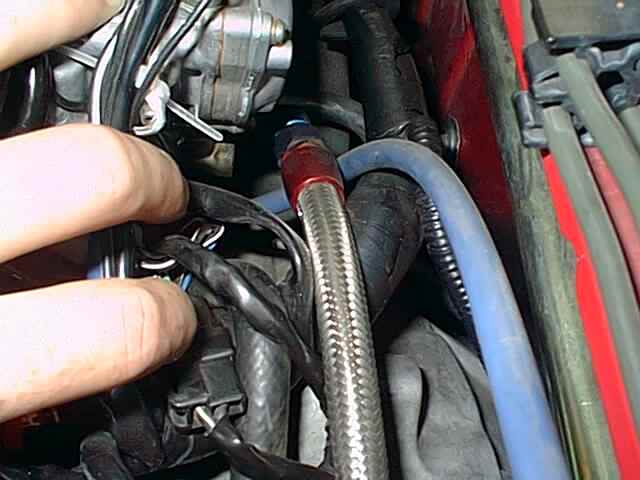
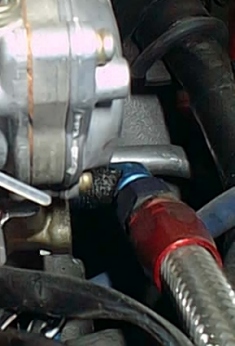

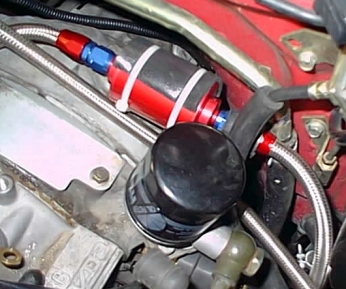
__________________
Date: Wed, 5 Apr 2000 08:48:29 -0400
From: "Karagiannis, Demetrios Mr ODCSINT/GD" (Demetrios.Karagiannis@hqda.army.mil)
I'm using a SX FPR and at idle (vacum) Pressure is about 40psi and as boost presure rises so does the fuel pressure at a 1:1 ratio.
_________________
Date: Wed, 05 Apr 2000 13:05:19 -0500
From: Gordon Monsen (gmonsen@fast.net)
I am using a RR FPR i got from Brian Richards (Mostly Mazda) at his recommendation. It cost around $300 or so. i have mine set to go from about 38-40 psi to about 65-70 psi. It has a screw valve without any clicks or gradations, so you just screw it out and try it, while looking at your fuel pressure gauge. This means at 15 psi boost I've got it set at about 1.5:1. Yes, it does increase the amount of fuel you flow for a given duty cycle and I believe it also atomizes the fuel more finely. -gordon
___________
Date: Wed, 5 Apr 2000 18:15:01 GMT
From: skan@ticnet.com
I'm a bit confuse on the 1.5:1 ratio @15psi you were given on your post?? Most FPR has a 1:1 ratio given that you have a linearly rise FPR. What that means is that it'll add an additional 15psi of pressure @15psi to your fuel pressure. For example, if you're running 40psi @ idle (neglecting vaccuum), your fuel pressure will be around 55psi at 15psi of boost.
Also, depending upon the types of injectors you have you may not want to run anything higher than 80psi since it may crack the injectors from the pressure.
_____________
Date: Wed, 5 Apr 2000 17:03:41 -0400
From: "kevin kelleher" (kellehkj@earthlink.net)
> Does running higher pressure actually make > more fuel come out of the injectors for a certain > duty cycle? I'm thinking about going ahead and > putting an aftermarket RRFPR in
Normal regulator maintains constant pressure difference between intake manifold and fuel rail pressure ( 38 psi stock). Increasing this value results in increased fuel delivered, in open loop mode ( ex wot), based on sq-root of pressure ratio.
Stock supply at 15 psi boost is 38+15=53 psi
For 70 psi at 15 psi boost, pressure drop is 70-15=55 psi across injector.
Increased flow at 70 psi, open loop, vs stock, is sq-rt(55/38)=1.20 or 20%, if injector can handle pressure.
Note that pump flow capacity decreases at higher pressures. better verify set-up with a fuel pressure gage for road testing.
_______________
Date: 7/21/00 3:43 PM
From: Max Cooper (MCooper@eBuilt.com)
Subject: Re: (rx7) fuel mods for 400hp
The stock injectors and fuel pump are inadequate for 400 RWHP at that stock fuel pressure. The limit of the stock pump seems to be about 340 RWHP and the stock injectors max out at 360-385 RWHP .
You might be able to stay with the stock injectors if you raise the fuel pressure. You can raise the pressure with an ADJUSTABLE fuel pressure regulator, which increases the pressure all the time and matches boost pressure with a 1:1 increase in fuel pressure. For example, if you have an adjustable regulator and you set it to 55 psi, you will get 55 psi at zero manifold pressure, and 65 psi at 10 psi of boost. A change like that will deliver SQRT(55/37) = 1.22 times the fuel delivered at the stock pressure, a 22% increase.
A different approach to raising fuel pressure is to use a RISING-RATE fuel pressure regulator (RRFPR). These are often confused with ADJUSTABLE regulators, but they are different in operation. RISING-RATE regulators add fuel pressure in some multiple of the boost pressure. If you add a RISING-RATE regulator and set it to a 3:1 ratio, you will get 37 psi at zero manifold pressure (stock pressure). At 10 psi of boost, you will get [37+10 psi from stock regulator] + [3*10 psi from RRFPR] = 77 psi. A change like that will deliver SQRT[(77-10)/37] = 1.35 times the fuel delivered at the stock pressure, a 35% increase. (Note that the increase is the square root of the new over old fuel pressures relative to the manifold).
If you decide to upgrade the injectors, keep in mind that the stock ECU operates best when the RATIO of the sizes of the primary to secondary injectors is near stock (550/850 = 0.65). The readily available sizes for stock-style side feeed injectors seem to be 550, 850, 1050, and 1200 cc/min. You can also get a new secondary fuel rail with top feed 1600 cc/min injectors (or a variety of other sizes). Mix and match to see what might work.
You will need a higher-flowing fuel pump. If you decide to increase the fuel pressure, you will need a substantially higher flowing pump. Do not accept characterizations like "this pump is good for 700 HP". Figure out what pressures you will be running and what fuel flow you need and then choose a pump. I suspect that the 255 Lph pump might be okay at the stock pressure, but probably won't cut it at higher pressures. That is just a guess -- do the research so you will know for sure. Watch out for pump test voltages, flow given in HP (not all cars make the same HP at the same fuel flows), and most importantly pump test pressures.
Another technique for getting more fuel from your pump is a voltage booster device. You may choose to use one with the stock pump (maybe not) or a moderate upgrade. Get a fuel pressure gauge (taped to windshield or a dash install) and watch out for pressure drops. When you exceeed the limits of your fuel pump, the pressure drops.
_______________
Date: Fri, 21 Jul 2000 18:17:19 -0400
From: Wael El-Dasher (wael.el-dasher@efini.net)
Subject: Re: (rx7) fuel mods for 400hp
I just talked to Brian Richards and he explained to me that the adjustable RRFPR they sell does not begin to add fuel until you pass 10psi of boost pressure. I called the manufacturer later to ask a few questions and inquired if what Brian said is true. I was informed by Corky at Bell Engineering that they build several variations of their regulators according to the tuner's requirements. In this case it makes the fuel pressure at 2:1 only past 10psi of boost (ie past stock levels).
So the math would be:
37psi at zero boost pressure + 10psi (stock regulator 1:1) = 48psi.
Anything past 10psi is 2:1 per additional pound of boost. In my case at 13psi means an additional 6psi of fuel pressure (2*3psi boost) so a total of 54psi (3.72 bar).
Just thought we should include this "different" fuel regulator setup to the list. But I have a question.
Well this is all nice, but I need to lower the duty cycle as at 13psi of boost my duty cycle is 85%. I want to bring that down to perhaps 70% or 65%.
How much fuel pressure should I set my adjustable RRFPR to at 13psi of boost? My estimate is about 70psi of fuel pressure (just under 5bar).
________________
Date: Sat, 22 Jul 2000 01:27:11 -0400
From: "kevin kelleher" (kellehkj@earthlink.net)
> So for example, at 10psi the stock regulator adds 1 psi of fuel pressure for > every 1 pound of boost pressure. At 1 psi (or zero) the fuel pressure should > be around 37 or 38psi. Let's say 38psi at 1psi of boost, so at 10psi the > fuel pressure will be 47psi.
Correct. 37 + 10 x 1 = 47 supply pressure.
> The rising rate will add 3psi of fuel pressure for every 1 psi of boost. At > 10psi it will add (to the stock fuel pressure) 30psi on top of what the > stock regulator adds.
The 3:1 RR unit Max noted will add 20 psi over stock addition, at 10 lbs boost.
Stock unit had raised pressure 10 psi at 1:1 .
> This brings the total to 47psi(from stock regulator) + 30psi (from > additional RRFPR) to a total of 77psi.
no, 37 + 10 x 3 = 67 psi
> ....... Bell Engineering have a new RRFPR > that can go as high as 15:1 !
Bell developed this and other high gain RR units for his turbo add-on kits. They would be set to kick in at, say 4 psi, when the stock NA injectors maxed out, and provide more fuel for higher boost purely by huge pressures across the injectors. The gains are reduce by the signal bleed valves.
Vortec also makes high gain RR regulators, with bleed adjusters.
Dave at KD Rotary has less expensive units with fixed gains (around 1.3 or 1.8) that are well suited for mods with stock pumps and ecu. No bleed valve, but adjustable base value.
__________________
Date: Fri, 21 Jul 2000 23:28:18 -0700
From: Max Cooper (max@maxcooper.com)
> I keep looking at the Fuel Pressure Solenoid valve and can not figure out > mechanically, how it raises the fuel pressure during hot starts...any ideas > of what passage the air takes through it?
I think it blocks the vacuum signal to raise the pressure. Just like boost pressure raises the fuel pressure, vacuum makes it drop. The solenoid just blocks the vacuum to make it drop. I am guessing that it plugs the vacuum line from the manifold, and vents the line connected to the FPR to atmosphere.
___________________
Date: Thu, 05 Apr 2001 17:44:50 -0500
From: "RX7 BLITZ" (rx7blitz@hotmail.com)
I have compiled a list below of different companies/dealers for a Rising Rate Fuel Pressure Regulator.
I have also seen a recalibration kit for some of the least expensive models. Do we need to calibrate it and do the expensive ones need it too?
Comptech - Brand new - part number 15.0000 - $259.00 Vortech FMU - Seen recalibration kits for this - $150.00 M2 Performance - $240.00 Belltech Eng. - part number 20008 - $259.00 <---sounds nice Rx-7 Store - SX - 1:1 = $149 or 1:3 = $199 ShaneRacing - $249.00 Paxton - ??? Malpassi - ???
____________________
Date: Fri, 6 Apr 2001 12:39:31 -0400
From: "Kevin J Kelleher" (Kevin.J.Kelleher@USA.dupont.com)
> .... I have (SR), and it works fine. It is adjustable from no effect > (stock 1:1 drives the pressure) to way more fuel pressure than > I would ever run. There is no adjustment for base fuel pressure. > This works fine because I think you will want to leave the base > pressure at the stock level and just enrich the fuel under > boost ........... Someone mentioned to me once that some of > these can be adjusted so that they don't ramp up the fuel > pressure until a certain pressure threshold is reached. I always > think of them as ramping (somewhat) linearly from zero manifold > pressure, but if this isn't the case I'd like to hear about it.
All secondary regulators like your SR are 'intercept type' pressure ramps, that over-rule the primary (oem) FPR and increase fuel pressure. The oem unit has a linear pressure/boost curve, that is 2.5 bar at zero boost, and 1:1 slope. The add on will have a similar, steeper, usually linear curve. Just plot the 2 curves, and the higher fuel pressure value is the one that governs, and the kick in point is the intersection of the 2 curves.
If secondary unit has a fixed or adjustable base pressure, that is the fuel pressure at zero boost, and the gain will give the slope, for both boost and vacuum conditions. These have internal preload springs.
If the secondary unit has no spring, the curve starts with zero psi fuel at zero boost. These usually have high gains (10:1), and were designed for add on turbos, where oem fuel system is quickly maxed out.
Some like SR have adjustable gain. These actually have some fixed gain, like 4:1, and a simple bleed valve knocks down the signal pressure, for lower gains. Some non-linear error in the gain occurs on these. Both kick in point and gain change with the signal bleed off adjustment.
It would be interesting to close off your bleed for full gain, and get a few data points where it is governing, and then extrapolate to see if the base pressure is zero, or mabe 2.5 bar.

[Mail me] [To Lightning home] [To my home page] [Copyright Notice]